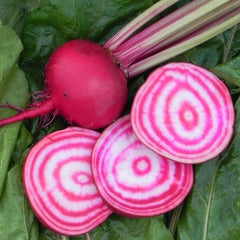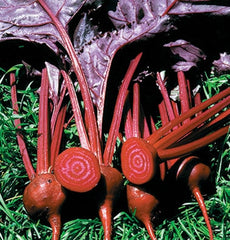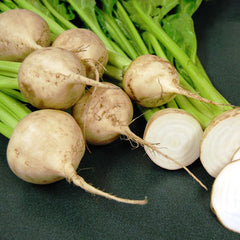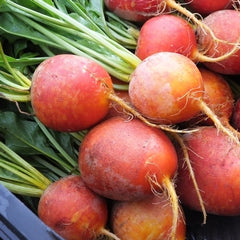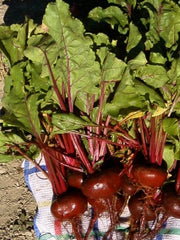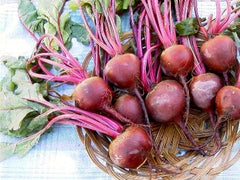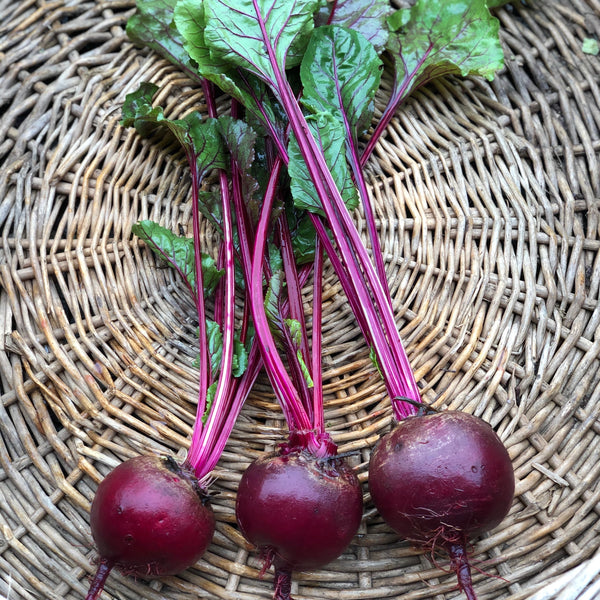Feuer Kugel
Beta vulgaris beet
HOW TO GROW BEET
Usually direct sown as soon as soil can be worked but may be started indoors. Summer sowing after mid July are generally poor. If you like, when direct sowing, mix beet seeds with fast-sprouting radish seeds to mark the rows. Start indoors 4-6 weeks before last frost, plant out 2 weeks before frost. For fall harvest, transplant 10 weeks before first frost, without additional protection. In a hoophouse, you can plant 2-3 weeks later. Sow every 3-4 weeks for consistent supply. Harvest beets when 2–3” for best sweet flavor. Beets can grow large and get woody if left in the field. All parts of the beet plant are edible. Soil pH 5.6-7.0. Hardiness zones 8. Biennial.
Days from maturity calculated from the date of seeding. Average 2,800 seeds per ounce. Average 436M seeds per acre. Federal germination standard: 65%. Usual seed life: 6 years. Isolation distance for seed saving: 5 miles.
Planting Depth 1/2”
Soil Temp. Germ. 50-85˚F
Days to Germ. 5-10
Plant Spacing 4”
Row Spacing 12-18”
Days To Maturity 60 days
Full Sun, Moist Well Drained
Days from maturity calculated from the date of seeding. Average 2,800 seeds per ounce. Average 436M seeds per acre. Federal germination standard: 65%. Usual seed life: 6 years. Isolation distance for seed saving: 5 miles.
Planting Depth 1/2”
Soil Temp. Germ. 50-85˚F
Days to Germ. 5-10
Plant Spacing 4”
Row Spacing 12-18”
Days To Maturity 60 days
Full Sun, Moist Well Drained
- 150 Seeds$4.10
- 1500 Seeds$15.50
German for “Fire Ball”, these vigorous plants yield smooth, red, round roots and a lush top of greens. They are excellent for early market bunching, or as a storage beet that can last through the winter. They have a dark red exterior, lighter red interior, and some white zoning on the cross section. They stay tender...
German for “Fire Ball”, these vigorous plants yield smooth, red, round roots and a lush top of greens. They are excellent for early market bunching, or as a storage beet that can last through the winter. They have a dark red exterior, lighter red interior, and some white zoning on the cross section. They stay tender and sweet even when large! Tags: Color: Red, Specialty: Storage, Season: Spring Fall.
Learn More
Meet Your Farmer
We promote fair trade, organic practices and environmental responsibility throughout the Restoration Seeds supply chain. Below are the family farmers and seed suppliers who bring our open pollinated seeds to you.
Deep Harvest Farm
Certified Organic by WA Dept. of Ag.
Seed grower since 2010


Deep Harvest Farm is a certified-organic vegetable, seed and flower farm on Whidbey Island in NW Washington. Run by Annie Jesperson and Nathaniel Talbot, the farm focuses on year-round vegetable production, taking extra steps to use ecological soil management practices such as minimal tillage, the use of compost and cover cropping.
Reviews



